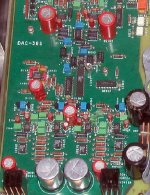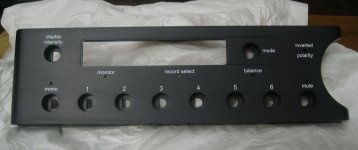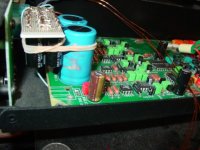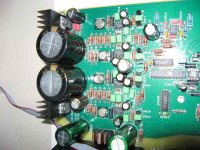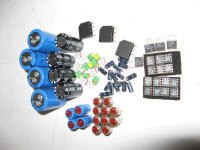Algar_emi said:Just received the plates. they are perfect. Looking just great 😎
Now I regret I didn't go with a program 😉
I received an e-mail inquiry about the mods I did on the preamp, so here it goes:
The rectifiers has been changed to MUR860 (MSR860 in digital section). The first pair of caps are BG F 1000/50 (STD is fine here as well). The second pair of caps before regulators are BG N 1000/50 (those worked here the best).
The regulators are LM2937/LM2990 and are much better than previous 78/79XX variety.
The above mods give the biggest improvement to the preamp.
I'm using BG N 47/50 right after regulators, BG N 47/50 at the buffer stage and BG N 100/50 at the input section.
The input section is using OPA627BP (which sounds better here than AP grade). The only bypas on those chips are BG N 4.7/50. If you came to conclusion that: "have taken away all the extra add on coupling and decopling capacitors as mentioned in the thread (the so called Class A resistor on the 627 has been disconnected long time ago) and it sounds better" you are on the right track. Those "upgrades" didn't work here well.
The next stage (single ended/balanced conversion) is using LM6172 chip and it worked better than other dual chips I tried (I didn't try AD797 though).
The I/V chip is AD823 and I replaced 1K resistors with 100R values.
All the bypases as you see in a picture are mostly Vishays 0.01 caps, which work slightly better than original Wimas. The output buffer small bypas caps were changed to BG N 4.7/50 and this made quite a difference.
I also tried swapping input gain setting Dales for Rikens, but it din't work well. I changed the input gain switch with a new chip, but also didn't observe any improvement.
One other thing is replacing output signal PCB traces with silver wire, but again I expected a bit bigger improvement.
That's about all, and this preamp now, sounds much better than the original ML38S, which basically as unneceptable and a single pot at amps input sounded better to me.
I also have S&B102 based preamp that I can use anytime, but somehow, always prefer the active preamp, especially when used with balanced output.
BG N take quite long to properly break in, an initially the sound is pretty much diffused and warm without much definition. Later it improves substantially. The red BG caps are also sensitive to orientation and my preference is to mount NON POLAR print on a cap where normally + goes.
The rectifiers has been changed to MUR860 (MSR860 in digital section). The first pair of caps are BG F 1000/50 (STD is fine here as well). The second pair of caps before regulators are BG N 1000/50 (those worked here the best).
The regulators are LM2937/LM2990 and are much better than previous 78/79XX variety.
The above mods give the biggest improvement to the preamp.
I'm using BG N 47/50 right after regulators, BG N 47/50 at the buffer stage and BG N 100/50 at the input section.
The input section is using OPA627BP (which sounds better here than AP grade). The only bypas on those chips are BG N 4.7/50. If you came to conclusion that: "have taken away all the extra add on coupling and decopling capacitors as mentioned in the thread (the so called Class A resistor on the 627 has been disconnected long time ago) and it sounds better" you are on the right track. Those "upgrades" didn't work here well.
The next stage (single ended/balanced conversion) is using LM6172 chip and it worked better than other dual chips I tried (I didn't try AD797 though).
The I/V chip is AD823 and I replaced 1K resistors with 100R values.
All the bypases as you see in a picture are mostly Vishays 0.01 caps, which work slightly better than original Wimas. The output buffer small bypas caps were changed to BG N 4.7/50 and this made quite a difference.
I also tried swapping input gain setting Dales for Rikens, but it din't work well. I changed the input gain switch with a new chip, but also didn't observe any improvement.
One other thing is replacing output signal PCB traces with silver wire, but again I expected a bit bigger improvement.
That's about all, and this preamp now, sounds much better than the original ML38S, which basically as unneceptable and a single pot at amps input sounded better to me.
I also have S&B102 based preamp that I can use anytime, but somehow, always prefer the active preamp, especially when used with balanced output.
BG N take quite long to properly break in, an initially the sound is pretty much diffused and warm without much definition. Later it improves substantially. The red BG caps are also sensitive to orientation and my preference is to mount NON POLAR print on a cap where normally + goes.
Attachments
Peter,
Noted with thanks.
I have a question about the bypass caps on the output buffer. The originals were 100uF 16V. Would it be too small by changing them to 4.7uF 16V BG N? Did you try BG N 33uF 16V? Which one would you guess that can produce a tighter bass that is comparable to the S&B102 passive preamp?
Sunny
Noted with thanks.
I have a question about the bypass caps on the output buffer. The originals were 100uF 16V. Would it be too small by changing them to 4.7uF 16V BG N? Did you try BG N 33uF 16V? Which one would you guess that can produce a tighter bass that is comparable to the S&B102 passive preamp?
Sunny
When you look into output buffer of ML36 DAC, which is using exactly same configuration as the preamp, you will notice that the small bypass caps they used there are 10/50.
I wouldn't expect 4.7u to be too smal here, and BG N 33/16 are actually to big in size to fit.
As I remeber replacing those caps brought quite an improvement. Also, comparing to S&B 102 passive preamp I'm not noticing much difference in bass performance. Actually it seems like active preamp is more dynamic, in my setup.
Usually, with BG caps, STD grade has better bass than N type, however they lack mids and highs finese. FK may better combine virtues of both types, but I don't have much experience with those caps.
I would suggest to try playing with main filter caps first, if tighter bass is what you are looking for. Nichicone FG 4700/63 could be considered, as well some of the "For Audio" Panasonic caps. BG N caps are probably not the best choice for a tighter bass.
I wouldn't expect 4.7u to be too smal here, and BG N 33/16 are actually to big in size to fit.
As I remeber replacing those caps brought quite an improvement. Also, comparing to S&B 102 passive preamp I'm not noticing much difference in bass performance. Actually it seems like active preamp is more dynamic, in my setup.
Usually, with BG caps, STD grade has better bass than N type, however they lack mids and highs finese. FK may better combine virtues of both types, but I don't have much experience with those caps.
I would suggest to try playing with main filter caps first, if tighter bass is what you are looking for. Nichicone FG 4700/63 could be considered, as well some of the "For Audio" Panasonic caps. BG N caps are probably not the best choice for a tighter bass.
After a few more months of different caps, I finally settled with the following modifications in chronicle sequence: -
Using Rubycon ZA 10uF 35V on the output buffer - it immediately tighten the bass without scarifying the high.
Using Silmic 47uF 63V on the buffer stage - the overall sound becomes smoother
Changed the Vishay 0.047uF bypass of the OPA627 to Rubycon ZA 4.7uF 25V in parallel with Auricap 0.047uF - improvement on bass and high extension.
Dismounted the DC regulators (as shown on pic) and changed the power supply to DACT CT-102 - the system becomes very detail. I can find more details that I didn't hear before. However, I bypassed the original 6800uF on the PCB that the bass became weak.
Since the CT-102 already has a 4700uF FC at the output stage, I paralleled 8 x 560uF 50V Rubycon ZL on the PCB and the bass returned with a very fast response.
Now the entire system is becoming very detail and dynamic. I appreciate it very much as I can now put aside my Django (passive pre-amp) now. My next step is to replace the onboard 5V power supply externally so that I can build an external power supply unit for the entire pre-amp. The most significant improvement came from replacing the onboard power supply by 2 units of CT-102 but it also cost me a lot of money.
Can anyone provide me with a good and quiet 5V supply circuit?
Using Rubycon ZA 10uF 35V on the output buffer - it immediately tighten the bass without scarifying the high.
Using Silmic 47uF 63V on the buffer stage - the overall sound becomes smoother
Changed the Vishay 0.047uF bypass of the OPA627 to Rubycon ZA 4.7uF 25V in parallel with Auricap 0.047uF - improvement on bass and high extension.
Dismounted the DC regulators (as shown on pic) and changed the power supply to DACT CT-102 - the system becomes very detail. I can find more details that I didn't hear before. However, I bypassed the original 6800uF on the PCB that the bass became weak.
Since the CT-102 already has a 4700uF FC at the output stage, I paralleled 8 x 560uF 50V Rubycon ZL on the PCB and the bass returned with a very fast response.
Now the entire system is becoming very detail and dynamic. I appreciate it very much as I can now put aside my Django (passive pre-amp) now. My next step is to replace the onboard 5V power supply externally so that I can build an external power supply unit for the entire pre-amp. The most significant improvement came from replacing the onboard power supply by 2 units of CT-102 but it also cost me a lot of money.
Can anyone provide me with a good and quiet 5V supply circuit?
Attachments
My own version of the ML380S upgrade from ML38S. I replaced the audio channels rectifiers with MUR860, then I replaced the caps with Nichicon MUSE FX Green and KG Gold. For the Gold I had to use 10000uF caps bigger than the original ones. The voltage regulators LM78xx were changed for low dropout regulators.
Input section. I replaced the LT1217 with OPA627AP and the needed small Wima green caps with blue ERO caps. The two blue electrolytic were changed with LX green.
The volume control IC opamp was changed for the AD823. The 4 small metallic electro caps 68uF were changed with 100uF,50V, Nichicon KZ Muse
Bigger change was in the output section. I replaced all the small 10uF, 50V caps with BG 10uF, 50V. And the expensive one, I replaced all the SSM2220 and 2210 with the new metal can MAT02 and MAT03. I used 8 pins DIP socket with removed pins as TO78 to DIP adapter, works well.
For the digital section I used UG4D, the two smaller caps were replaced with OSCON caps.
Input section. I replaced the LT1217 with OPA627AP and the needed small Wima green caps with blue ERO caps. The two blue electrolytic were changed with LX green.
The volume control IC opamp was changed for the AD823. The 4 small metallic electro caps 68uF were changed with 100uF,50V, Nichicon KZ Muse
Bigger change was in the output section. I replaced all the small 10uF, 50V caps with BG 10uF, 50V. And the expensive one, I replaced all the SSM2220 and 2210 with the new metal can MAT02 and MAT03. I used 8 pins DIP socket with removed pins as TO78 to DIP adapter, works well.
For the digital section I used UG4D, the two smaller caps were replaced with OSCON caps.
Attachments
With so many parts replaced, I really need to recook the preamp with some run-in. Initial listening is very good. It is a very transparent preamp. As a test setup (not a very good one I agree), I use my Assemblage Dac 2.6, SDS Headphone amp and my Grado SR125 headphone.
The preamp has powerfull bass, well balanced medium and clean as crystal highs. It is very revealing. It doesn't mask or help a bad recording. You can hear details everywhere, certainly not dark sounding as Stereophile qualify
ied the original ML38.
I tried the preamp balanced outputs with my Aleph 30 and a battery powered DAC. At maximum volume, there was only a very low hiss coming from the tweeters. At normal listening volume it is silent as a tomb. With the Aleph it sounds very delicate. You need a very good source because it shows any weak link. The Assemblage DAC shows its limitations and sounds electronic. My battery dac sounds smooth but rather flat. Use a great source and WOW 😎. My tube DAC with the ML37 or my Esoteric Universal players are just gourgeous. A very good preamp indeed.
The preamp has powerfull bass, well balanced medium and clean as crystal highs. It is very revealing. It doesn't mask or help a bad recording. You can hear details everywhere, certainly not dark sounding as Stereophile qualify
ied the original ML38.
I tried the preamp balanced outputs with my Aleph 30 and a battery powered DAC. At maximum volume, there was only a very low hiss coming from the tweeters. At normal listening volume it is silent as a tomb. With the Aleph it sounds very delicate. You need a very good source because it shows any weak link. The Assemblage DAC shows its limitations and sounds electronic. My battery dac sounds smooth but rather flat. Use a great source and WOW 😎. My tube DAC with the ML37 or my Esoteric Universal players are just gourgeous. A very good preamp indeed.
Hey everyone...
I parted from my Mark Levinson N° 380s and still have a ML N° 38 mainboard packed in my cellar.
Along with it I have the original ML N° 38s frontpanel (right part with the laser engraving) and a couple of original components that were taken out of a N° 38s during upgrade to N° 380s.
Anybody interested?...
I parted from my Mark Levinson N° 380s and still have a ML N° 38 mainboard packed in my cellar.
Along with it I have the original ML N° 38s frontpanel (right part with the laser engraving) and a couple of original components that were taken out of a N° 38s during upgrade to N° 380s.
Anybody interested?...
Hi, mach.88 i am interested in your no.38 main board and front panel pls email me at Saifee69@hotmail.com thanx.
Miss the party
Hii,
I'm miss the best party here
Begin interested in audio at Jan 2007, because hear a beautiful
song "we're all alone" from RITA COLLIDGE in my best friend house with Rotel CD, Int Amp Marantz and KEF Speaker.
Make me peacefull and forget all my trouble
and forget all my trouble 
I hope there is still a little glass of wine around here
if someone have No 38, PCB original, PCB development, Layout, Layout development, Remote PCB, Remote PCB development, Panel [ F, B ] Remote, Remote development, component suggest and the other things about No 38 please contact me 🙄
Thank u very much to Peter Daniel, Algar_emi, sunsun22, trigon,
carlosfm for dedication in No 38
Algar_emi, Mach.88, PAM do you still have it ? i am interest in your no.38 main board and front panel pls email me at jeffry_widjaja@yahoo.com [dont forget photos to mach.88 ] 😉
Thank u for everything to learn a lot in diyaudio forum
very happy to read from solid state, page 429 until page 53 😀
regards,
JeffryW
sorry for my "Bad English", jeffry_widjaja@yahoo.com
Hii,
I'm miss the best party here

Begin interested in audio at Jan 2007, because hear a beautiful
song "we're all alone" from RITA COLLIDGE in my best friend house with Rotel CD, Int Amp Marantz and KEF Speaker.
Make me peacefull
 and forget all my trouble
and forget all my trouble 
I hope there is still a little glass of wine around here
if someone have No 38, PCB original, PCB development, Layout, Layout development, Remote PCB, Remote PCB development, Panel [ F, B ] Remote, Remote development, component suggest and the other things about No 38 please contact me 🙄
Thank u very much to Peter Daniel, Algar_emi, sunsun22, trigon,
carlosfm for dedication in No 38
Algar_emi, Mach.88, PAM do you still have it ? i am interest in your no.38 main board and front panel pls email me at jeffry_widjaja@yahoo.com [dont forget photos to mach.88 ] 😉
Thank u for everything to learn a lot in diyaudio forum
very happy to read from solid state, page 429 until page 53 😀
regards,
JeffryW
sorry for my "Bad English", jeffry_widjaja@yahoo.com
Hey guys,
thanks for all the inquiries but the board and its components went as fast as the post was edited on the screen.
For all of you still looking for a N° 38 board, check out this thread. A guy from Norway has a couple of them and if you can´t find any more... don´t bother! Build yourself a Pass Aleph P 1.7.
In regards to sonic performance it outperforms the N° 38 without a doubt...
Cheers
Chris
thanks for all the inquiries but the board and its components went as fast as the post was edited on the screen.
For all of you still looking for a N° 38 board, check out this thread. A guy from Norway has a couple of them and if you can´t find any more... don´t bother! Build yourself a Pass Aleph P 1.7.
In regards to sonic performance it outperforms the N° 38 without a doubt...
Cheers
Chris
- Home
- Amplifiers
- Solid State
- Building Mark Levinson 38 preamp chassis from scratch

